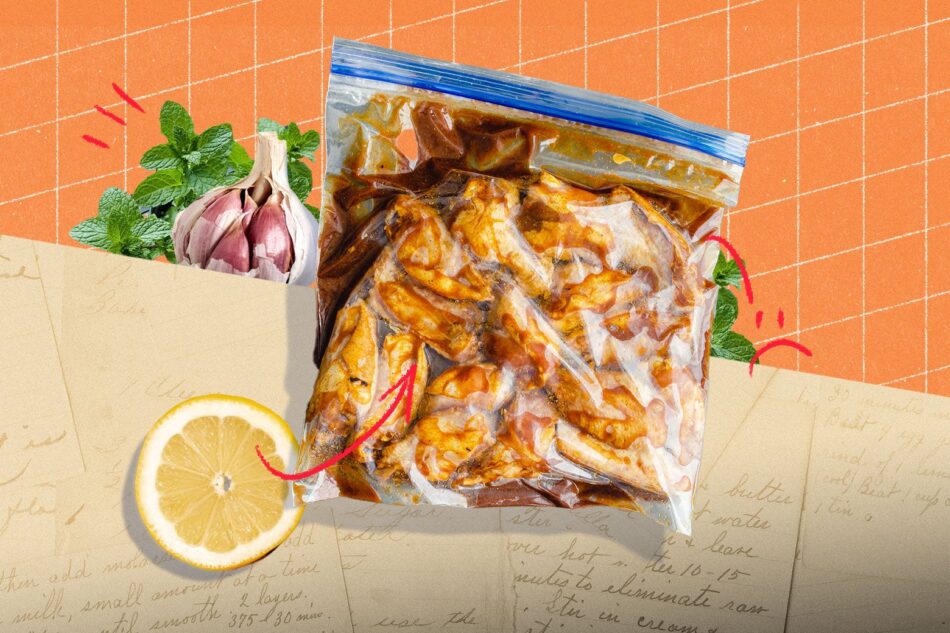Sign up for the Slatest to get the most insightful analysis, criticism, and advice out there, delivered to your inbox daily.
Recipe for Disaster is Slate’s column about the things recipes get wrong—and how to fix them. If you’ve noticed a recipe annoyance, absurdity, or outright lie, file your complaint here and we will investigate!
Throughout the summer while I was growing up, our family would regularly marinate and charcoal lamb. My Greek uncle, with his tanned, hairy arms, would stuff thick cubes of butchered lamb legs into 2-gallon Ziploc bags, then toss them around with extra-virgin olive oil, lemon juice, cloves of garlic, and fresh herbs like oregano and mint, using his hands to massage the meat from the outside of the bag. The lamb was always lovely, a core happy memory of my childhood. But as I got older, I started to wonder, How much of that marinade am I actually tasting? Sure, the lamb’s charred surface might whisper faintly of the garlic or lemon, but after that initial bite, the inside was relatively plain, with no marinade flavor to speak of. There was just no way the delicate taste of those herbs was exerting its influence on all that dense, gamy protein, right? Were my uncle’s sincere efforts really just elaborate culinary theater, a Greek tragedy playing out on the grill?
Now a (moderately) hairy-armed man myself, I’ve come to believe that marinades, in most cases, may as well be made of snake oil. The words magic and marinade appear next to each other often in recipes. And yet, there are many cooks like me—call us, as Slate’s Luke Winkie did last year, marinade truthers—who strongly feel that marinades are nothing more than a simulation, a government conspiracy or, at the very least, recipe subterfuge in order to get you to buy a cookbook. As Winkie puts it: “When I read a mandate to marinate the chicken thighs, or flank steaks, or pork belly for ‘at least six hours’ or ‘ideally overnight,’ I fall back on my base assumptions: There is simply no way a liquid nap makes that much of a difference.” Perhaps you too have been let down by meats promising explosive flavor after many hours in a complicated (and often kind of pricey) bath, only for them to taste … merely fine, or even disappointing.
Plump, hormone-filled chicken breasts with a subtly sweet skin but a relentlessly bland interior; wan steaks that would have been better off with a heavy salting and a proper sear; tasteless, almost sterile pork chops that should have been brined and crusted with a medley of spices—these are marinade’s victims, and it’s time we started trusting our senses and listening to them. Because, with all due respect to my uncle, marinades aren’t magic. But luckily for us, there’s a far more effective method of introducing powerful flavor to meats already on the table—we just have to stop messing around with marination long enough to see it.
Before I get to that, though, we need to address the fundamental question: How much flavor—if any—are marinades infusing into food? The answer is definitely less than you think.
As Tim Chin of Serious Eats discovered in his experiments—which consisted of marinating chicken, steak, and pork for various lengths of time with assorted ingredients—marinades are at best a superficial gloss:
Marination is mostly not a method for injecting flavor into the interior of proteins. Beyond salt, and a select few ingredients like MSG, there are few ways to season the interior without resorting to physically manipulating the meat so that the marinade can penetrate, such as injecting flavorings with a syringe. And apart from flavor, if you really want to transform the interior texture of meats, consider adding an acid, base, or enzyme to your marinade.
Tests have indeed shown that most marinades don’t flavor-penetrate (wow, what an unfortunate phrase) past the surface of the meat. That means that all those marinade aromatics—garlic, herbs, citrus rinds, liquid smoke, the list drones on—aren’t doing much. In fact, you’re basically wasting them. As Chin reports, those aromatics contributed an either zero or barely perceptible flavor to the interior of the meat. (Winkie’s piece goes into molecular-level detail on why.) That’s a big problem, especially for larger cuts, like the aforementioned roided-out chicken breast. It all raises a good question: Why marinate at all?
I asked Jack Bishop, chief creative officer at America’s Test Kitchen, what the team thinks of marinades, and his answers confirmed my own proclivities. “We often salt tough cuts of meat like chuck roast, as well as lean cuts like turkey, before cooking them. But we rarely marinate these cuts,” says Bishop. “That’s because marinades don’t really penetrate into the meat. If you want to boost flavor before cooking, a spice rub that sticks to the meat or bird is much more effective.”
I like that Bishop mentions spice rubs. Spice rubs are fragrant, vibrant, and wonderful, and they cling to the exterior of any meat, meaning you’re guaranteed big flavor, something that lingers on the tongue. At home, I use spice rubs for everything from pork chops to ahi tuna. (I wrote this here recipe for a black-pepper-and-coriander-crusted tuna steak.) Also, this feels like a good moment to address brines. I’m a brine guy. I always brine my chicken wings, and, really, all of the best chicken wings are brined. Brines involve soaking meat in a salt-water solution to improve their texture and get that salt infused throughout the cut. Brines aren’t right for everything, but in many cases, the flavor enhancement home cooks are expecting with marinades is likely better achieved with a simple brine.
But Bishop isn’t done offering sound alternatives to marinades: “And serving meats and poultry with a flavorful sauce is a more effective way to add herb, garlic, or citrus flavors.”
Aha: sauces! A consistent, reliable solution to any flavor problem. Remember the lamb of my youth? I left out a key detail—it wasn’t the marinade flavor I remember. It was the sauce. That lamb was always accompanied by toum (Lebanese garlic sauce) and hot peppers. And those bright, pungent sauces overpowered any subtlety of the marinade (if it was there to begin with). The tangy, garlicky, unctuous, spicy combination of toum and peppers soaked in oil was what stayed with me most. Beautiful, complex, bright, fiery, straightforward sauces are marvelous: chimichurri, gremolata, béarnaise, au poivre, Dijon cream, lemon butter—the list goes on and on.
Bishop isn’t the only culinary guru who thinks sauce is often more effective than a marinade. For more, I turned to somebody who has plenty of grilling experience but is also a master of sauces, Argentine chef Javier Bardauil. Bardauil is the owner and operator of Barda here in Detroit. Beef is central to Argentina’s culture and heritage. It’s a country renowned for its beef, so it’s no secret that Argentine chefs pride themselves on simple, pure culinary treatments. “In Argentine cooking, marinades aren’t as central as they are in other cultures,” says Bardauil. “We usually let the quality of the meat speak for itself. For steak, especially, we believe in simplicity—salt, fire, and time. If the animal lived a good life and was butchered with care, you shouldn’t need to cover that up.”
All the meat at Barda is prepared with these tenets in mind. According to Bardauil, “Fire is the real marinade.” Spoken like a true Argentine chef. At Barda, a pork tomahawk is crusted with coriander and served with summer peaches; a New York strip is seasoned only with salt and pepper, then served with a chimichurri compound butter and jammy rescoldo onions; beef short ribs are paired with a salsa criolla, and the hits keep coming. Bardauil knows how to wield fire, and he’s also an assassin with sharp, acidic sauces. Those skills prove to be a winning (or at least a James Beard–nominated) combination. There’s no need for marination at Barda. The sauce has all the extra flavor you need.
However, don’t mistake Bardauil for a purist. He admits that marinades have their place. “With leaner cuts, poultry, or offal,” he says, “In Patagonia, for example, you’ll find lamb or goat marinated in garlic, herbs, vinegar, or even beer before a long, slow cook over embers. It’s less about adding flavor and more about helping the fire work its magic over time.” Bardauil sees marinade as a specialty tool but reminds me that it is not a shortcut. Marinades can bring nuance and complexity, but they should never be used to mask the meat itself.
On the other side of this sizzling steak, perhaps no chef champions marinades quite like Jesse Griffiths of Dai Due in Austin, Texas. Griffiths has literally written books about butchering and cooking whole animals, so I trust his opinion. But he’s tactical and precise, and he has no illusions about what exactly a marinade is good for—in his hands, it’s not about aimlessly trying to season the interior of the meat but about maximizing the crust in terms of flavor and texture.
“Vinegar and sweeteners bring qualities like tenderizing and jump-starting the Maillard reaction by burning a little sugar onto the crust,” Griffiths says. “Using sweeteners like honey, maple syrup, or brown sugar in small amounts instantly sears on the grill. This is especially true on thinner cuts that benefit from quick development of a crust before the interior is overcooked.” (If you’ve ever been burned by a sweetened marinade that smokes up your house when it hits your skillet, this is why: The fire of a grill will perform the crusty magic Griffiths describes. The relatively weaker heat and slower cook of the stovetop will just leave you with a bitter, smoldering mess. Don’t listen to any recipe that tells you otherwise.)
After talking with him, I realize that even Griffiths understands that marinade isn’t a cure-all; rather, it’s part of a comprehensive cooking process. Take Dai Due’s pork chop, which is first brined in salt, sugar, bay leaf, and star anise. After the brining, the chop is then also marinated with black pepper, honey, and olive oil to “fill in the gaps,” according to Griffiths. Thus, the pork chop’s interior is imbued with sweetness, saltiness, and moisture with the brine, while the marinade takes care of the crust with honey and pepper. That means the chop is well crusted and flavored throughout. There’s an all-encompassing tactical operation going on here: It’s total cookery, not just a marinade.
And when you look at a map of the great marinades of the world, this holistic approach makes sense. Filipino bistek tagalog uses thinly (correctly) pounded strips of rib eye, which are then marinated briefly in soy sauce, calamansi juice, garlic, and raw white onions cut into rings. The marinade does add some texture, but the primary benefit comes from cooking the marinade mixture with the steak—long enough to create a sauce. Carne asada traditionally uses thin, tougher cuts of meat and is marinated an infinite number of ways, each one providing a different expression of personal flavor and culture. And what would Korean galbi be without its subtly sweet, sticky features? What would Indonesian chicken satay be without the protein’s deeply caramelized exterior imbued with kecap manis and peanut sauce? Each of these iconic dishes understands marinade and uses it in its proper place.
And here’s what that place is decidedly not: that you, via some disproven, hippie-dippie wave of a magic wand, imbue a hunk of protein with flavor simply by letting it wade in a plastic bag of useless muck. I hate to sound like some cookery conspiracy theorist, but we’ve all been lied to. The general public has been duped. Marinades are not some secret sauce. It turns out that the real secret sauce is, well, sauce—herby chimichurri, spicy zhug, garlicky toum, peanut-tamarind dipping sauce, and, heck, just a good old-fashioned mushroom cream sauce. Open your eyes, join the rest of us marinade truthers, and you’ll see you’re better off saving your precious ingredients and effort for whipping up one of those instead.







